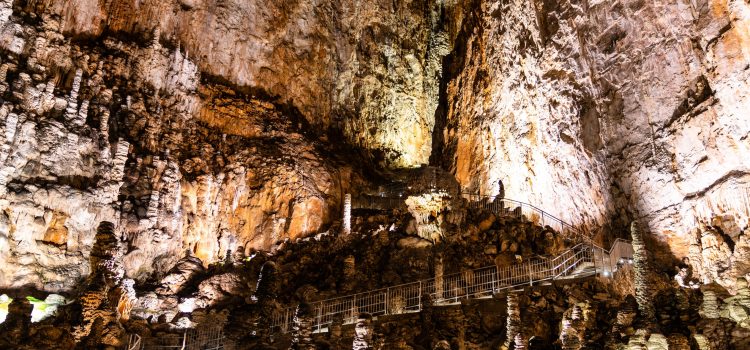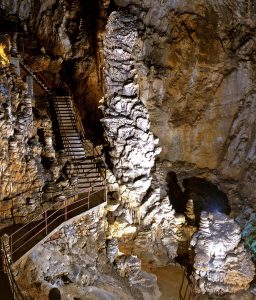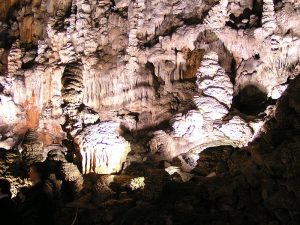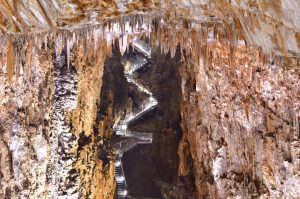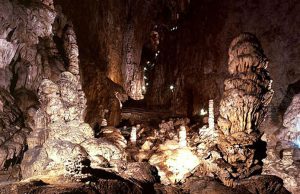GIANT CAVE TRIESTE
In 1995 Guinness Book of Records as “tourist cave containing the largest room in the world”. The Grotta Gigante, whose origin is traced back to at least ten million years ago, is a vast cavity present in the subsoil of the Trieste Karst, consisting of mainly calcareous and to a lesser extent dolomitic carbonate rocks. Numerous stalactites and stalagmites embellish the cave and among these, which currently grow at an average speed of 1mm every 15-20 years, the imposing “Colonna Ruggero” stands out, 12 meters high and formed in about 200,000 years.
Many of these stalactites have a reddish color, due to the presence of iron oxides. The cave has three natural entrances, two of which today constitute the entrance and exit of the tourist route respectively. All three flow into a huge underground cavern measuring 98.5 meters in height, 167.6 meters in length and 76.3 meters in width, for a volume of over 300,000 cubic meters. The entrance is located 274 meters above sea level, while the height of the cave floor measures 160.5 meters above sea level.
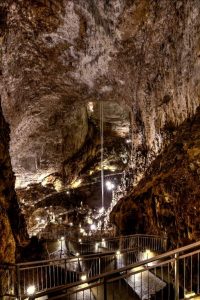 From the main cavern (called “Great Cavern”) a deep lateral branch also branches off, consisting of a series of communicating vertical karst shafts, the bottom of which is located at a depth of 250 meters below the surface and at an altitude of about 20 meters above the level of the sea. Some side galleries with a blind end branch off from the Grotto, the two main ones measuring 80 meters and 60 meters in length respectively.
From the main cavern (called “Great Cavern”) a deep lateral branch also branches off, consisting of a series of communicating vertical karst shafts, the bottom of which is located at a depth of 250 meters below the surface and at an altitude of about 20 meters above the level of the sea. Some side galleries with a blind end branch off from the Grotto, the two main ones measuring 80 meters and 60 meters in length respectively.La scoperta della Grotta comincia nel 1840 quando Trieste era il principale porto dell’Impero austroungarico e, grazie al boom economico, continuava ad espandersi velocemente. Ben presto le risorse idriche non erano più adeguate allo sviluppo della popolazione e poichè i corsi d’acqua presenti nel territorio, a causa del carsismo, venivano inghiottiti dai pozzi naturali e dalle gallerie delle rocce scavate sull’altipiano, non restava altro che cercare l’acqua nel sottosuolo. L’ingegnere montanistico Anton Friedrich Lindner andò ad esplorare alcune profonde cavità carsiche della zona, tra cui la stessa Grotta Gigante che però, era stata abbandonata ormai da milioni di anni dai corsi d’acqua che l’hanno scavata. Una nuova spedizione portò alla scoperta di due nuovi ingressi nel 1890. Uno di questi ingressi si prestava alla costruzione di scalinate per le visite turistiche e fu così che tra il 1905 ed il 1908 si costruì il primo percorso, ancora oggi in parte utilizzato.
In 1997 the new ascent route was built, dedicated to Carlo Finocchiaro, long-time president of the E. Boegan Caves Commission, in 2005 the new “Visitor Reception Center” was inaugurated, which also houses the Scientific Speleological Museum, while in 2007 the the exploration of the last side branch of the Grotta Gigante concluded, now dedicated to the speleologist Giorgio Coloni, which allows you to reach a depth of 250 meters with the help of a real via ferrata, and then ends at only 20 meters above the level of the sea and in 2009 the lighting system of the cave was completely renovated.
The Grotta Gigante is also a site of important scientific research in the field of Geology and Peleology, Paleontology, Archeology, Fauna and Flora until it hosts the longest Geodetic Pendulums in the world, used by the Department of Mathematics and Geosciences of the University of Trieste studies to monitor countless movements of the crust of our planet, from the terrestrial tides to the tectonic movements of the plates, to imperceptible vibrations generated by earthquakes that also occur on the other side of the world.



